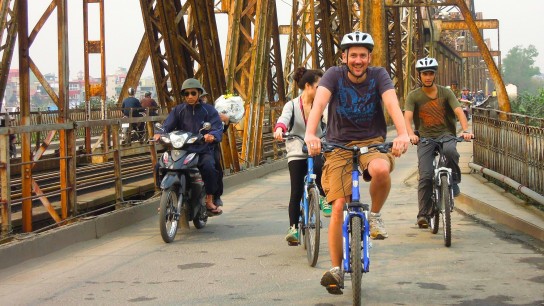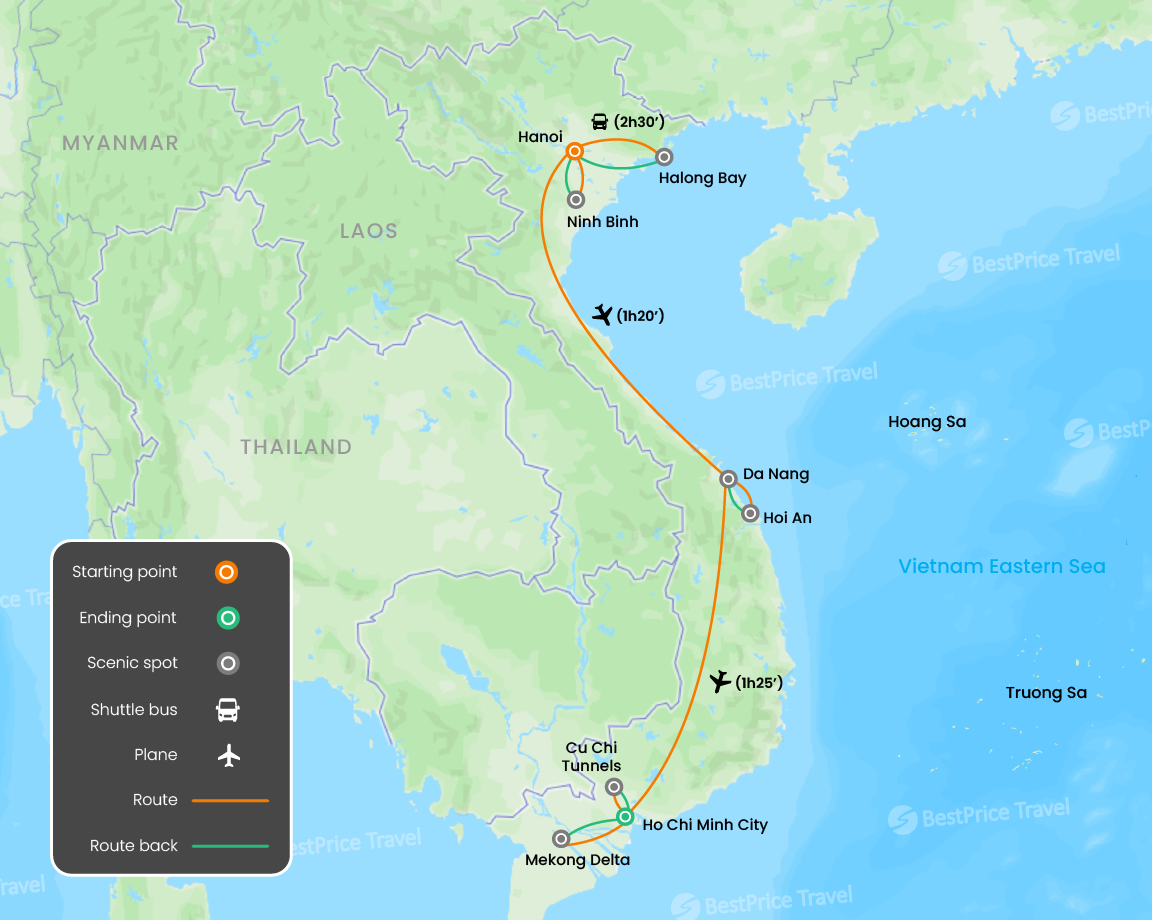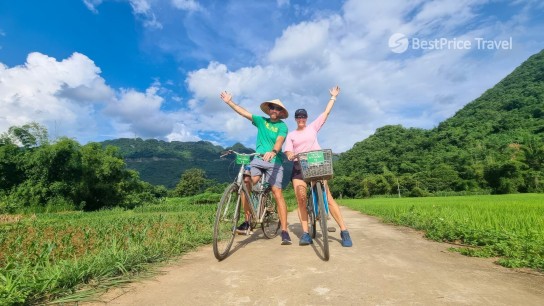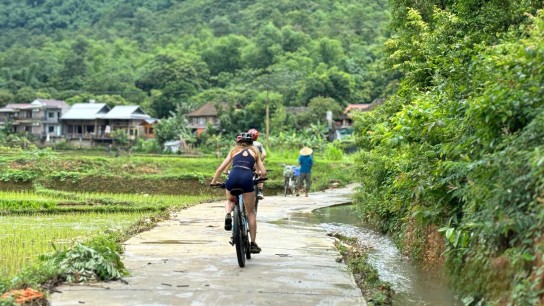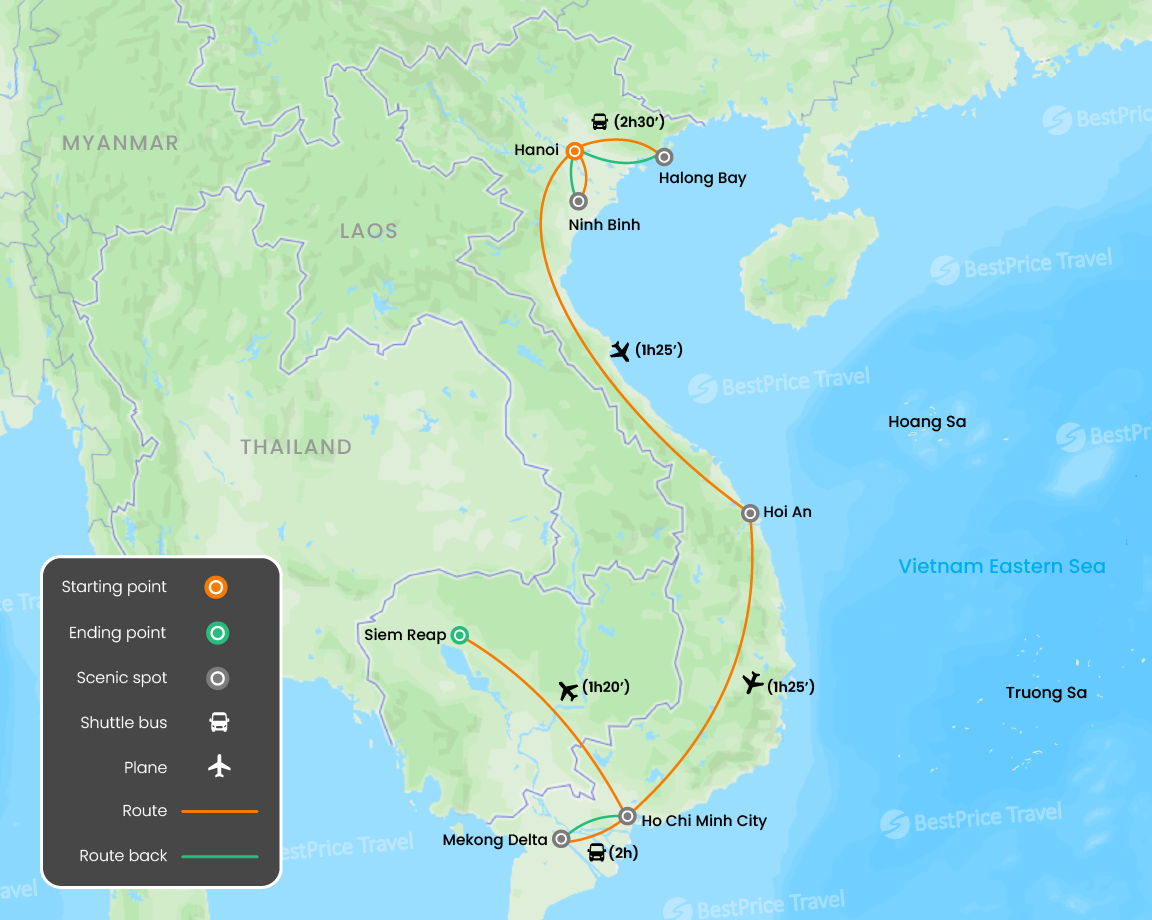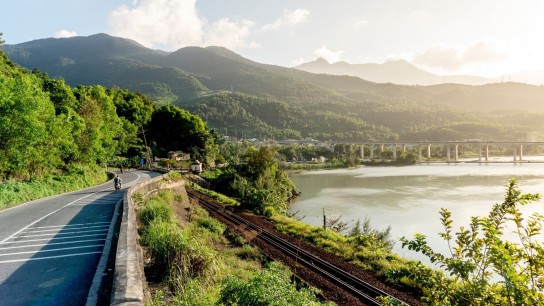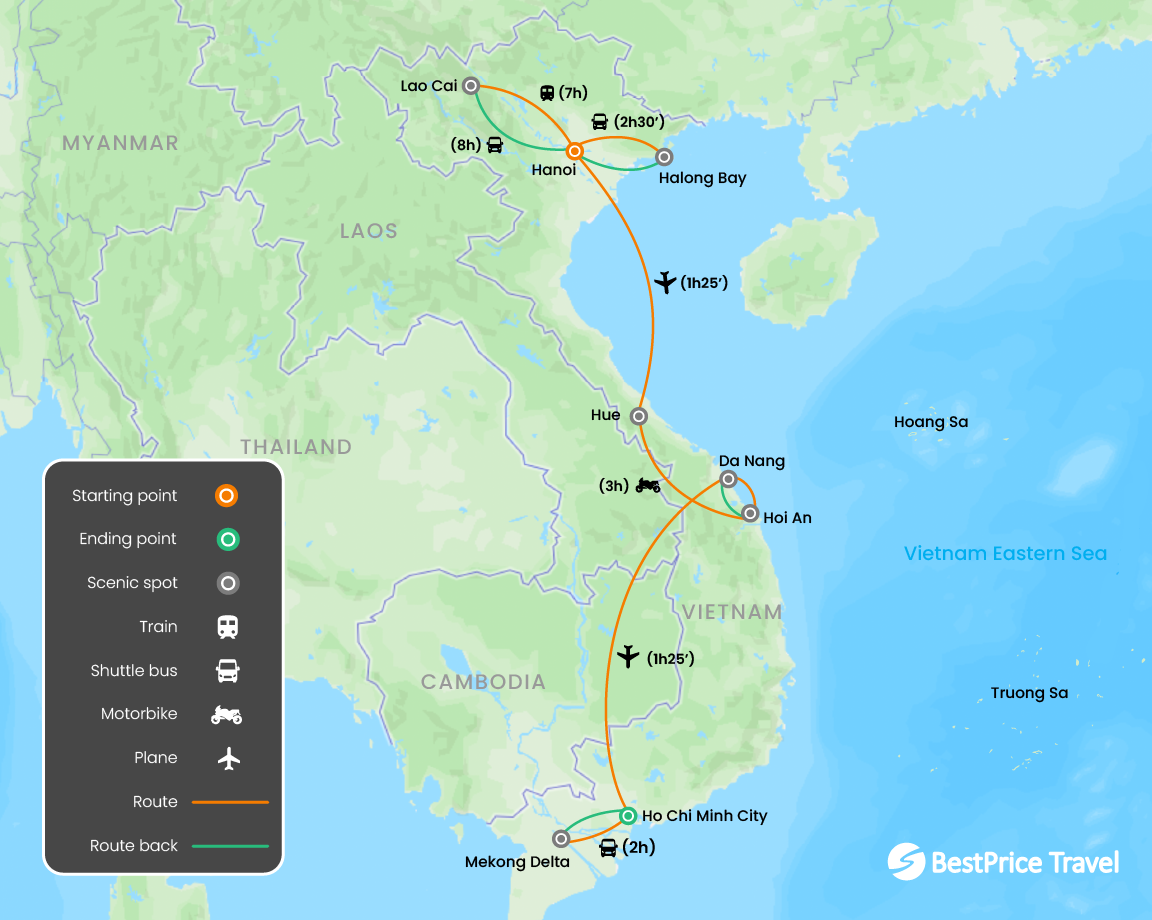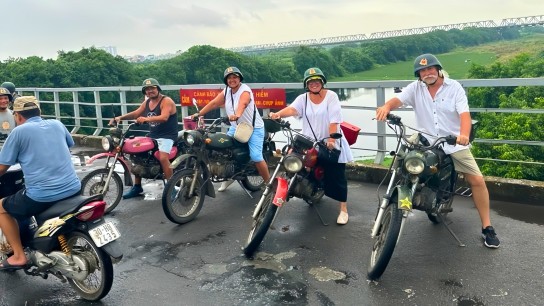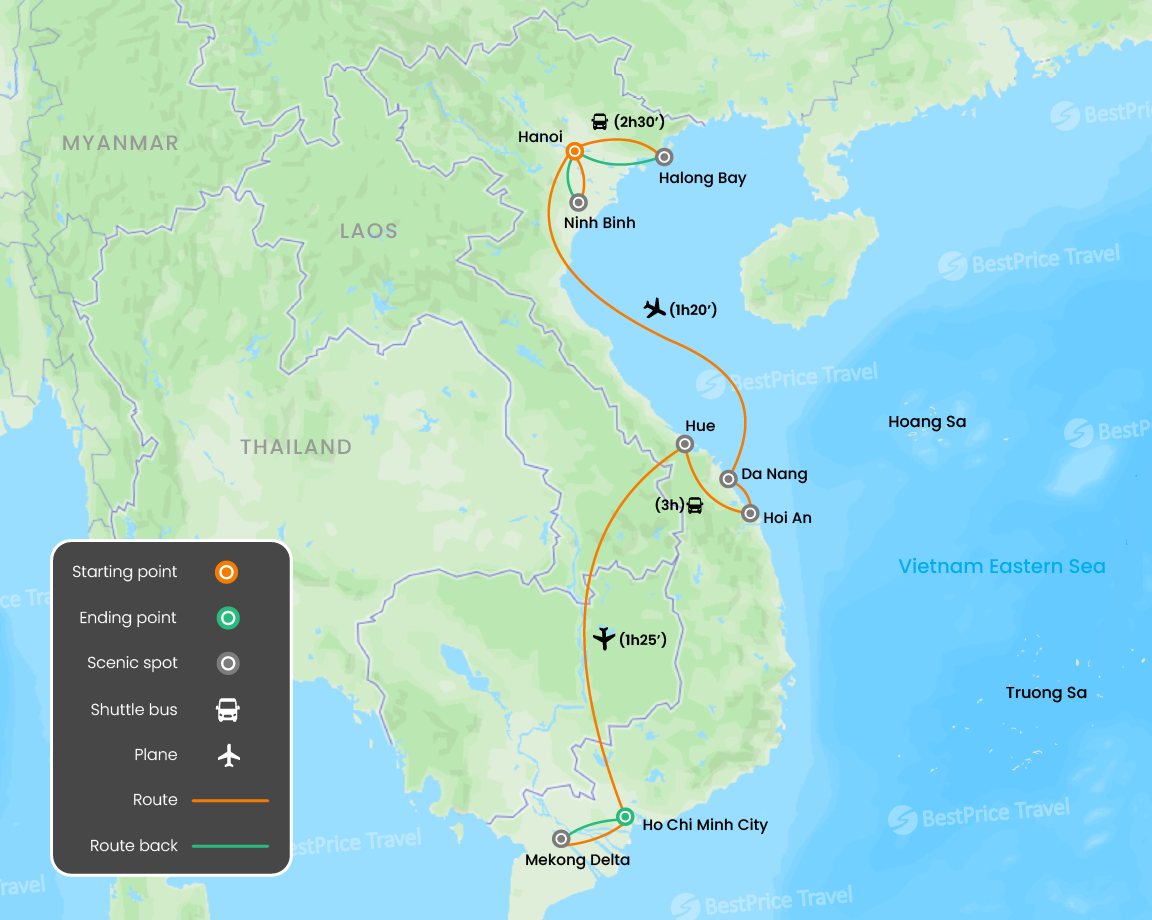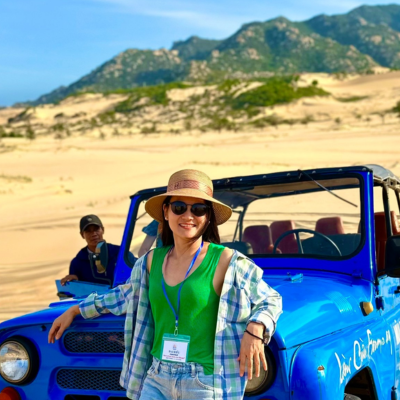Top 10 Vietnam Cycling & Bike Tours in 2026/2027 Loved by American Travelers
Vietnam Easy Biking And Cultural Journey 10 days
Hanoi - Halong Bay - Ninh Binh - Hoi AnTheme: Nature, Soft AdventureSuitable: Active TravellersHighlights- Cycle across Long Bien Bridge and explore the lush greenery of Banana Island in Hanoi
- Immerse yourself in the serene beauty of Tam Coc in Ninh Binh while gliding along the Ngo Dong River
- Experience the majesty of Halong Bay on a luxurious overnight cruise
- Uncover the vibrant culture of Hoi An, from lantern-lit streets to countryside workshops
- Venture into history at the Cu Chi Tunnels and the tranquil landscapes of the Mekong Delta
View tourfrom $1,349US$1,349/paxNorthern Vietnam Culture And Scenery By Bike 7 Days
9.7Excellent - 1 reviewI booked our tour through BestPrice Travel with Ms. Haley as our travel consultant,…Ms. Raquel H -![am]() amHanoi - Mai Chau - Halong BayTheme: Nature, Cultural, Soft AdventureSuitable: Seniors, Active TravellersHighlights
amHanoi - Mai Chau - Halong BayTheme: Nature, Cultural, Soft AdventureSuitable: Seniors, Active TravellersHighlights- Explore Hanoi's vibrant Old Quarter and experience its bustling street life
- Cycle through Mai Chau’s picturesque villages and lush mountainous landscapes
- Explore Halong Bay's emerald waters on an overnight cruise, discovering hidden caves and pristine islands
- Immerse in traditional Vietnamese cooking during a hands-on cooking class
- Experience the local culture with Thai dance performances and rice wine tastings
View tourfrom $539US$539/paxVietnam and Cambodia Family Biking Adventure 15 days
Hanoi - Ninh Binh - Halong Bay - Hoi An - Hue - Ho Chi Minh City - Mekong DeltaTheme: Nature, CulturalSuitable: Family with Kids, Active TravellersHighlights- Cycle through the vibrant streets of Hanoi, passing by its iconic landmarks and bustling markets
- Visit the serene landscapes of Tam Coc and the historic capital of Hoa Lu in Ninh Binh
- Cruise through the breathtaking limestone karsts and emerald waters of Halong Bay
- Stroll through the charming ancient town of Hoi An, admiring its well-preserved architecture
- Experience traditional wet-rice farming firsthand in the peaceful countryside of Hue
View tourfrom $1,939US$1,939/paxVietnam Adventure on Bike from North to South 16 days
9.4Excellent - 11 reviewsFrom start to finish, it is a thrilling and well-organized experience. We are happy…Fernando -![Italy]() ItalyHanoi - Sapa - Halong Bay - Hue - Hoi An - Ho Chi Minh City - Mekong DeltaTheme: Off the beaten track, Soft Adventure, NatureSuitable: Active Travellers, Singles & SoloHighlights
ItalyHanoi - Sapa - Halong Bay - Hue - Hoi An - Ho Chi Minh City - Mekong DeltaTheme: Off the beaten track, Soft Adventure, NatureSuitable: Active Travellers, Singles & SoloHighlights- Cycle along the iconic Long Bien Bridge, an architectural marvel with a rich history dating back to the French colonial era.
- Embark on an adventurous trek through the breathtaking landscapes of Sapa.
- Enjoy a night aboard a comfortable cruise, surrounded by the tranquility of the emerald waters and towering cliffs.
- Experience the vibrant energy of Ho Chi Minh City through an exhilarating Vespa tour.
View tourfrom $1,859US$1,859/paxVietnam Adventure On Wheels: North to South Exploration 15 days
9.6Excellent - 3 reviewsThanks, Jane...now that we are home in ireland I would just like to say a big thank…Ms. Donna M -![Ireland]() IrelandHanoi - Halong Bay - Hoi An - Hue - Ho Chi Minh City - Mekong DeltaTheme: Nature, Cultural, Soft AdventureSuitable: Active TravellersHighlights
IrelandHanoi - Halong Bay - Hoi An - Hue - Ho Chi Minh City - Mekong DeltaTheme: Nature, Cultural, Soft AdventureSuitable: Active TravellersHighlights- Experience local life while zipping through Hanoi's streets on vintage scooters
- Cruise through mystical limestone formations in world-heritage-listed Halong Bay
- Discover ancient rice farming traditions by bicycle in Thanh Toan Village
- Navigate the mighty Mekong Delta's waterways by traditional wooden boat
- Explore hidden alleyways and street food culture in Ho Chi Minh City
View tourfrom $1,450US$1,450/pax
FAQs
The best time for cycling tours in Vietnam is from October to April. During this period, the weather is cooler (ranging from 18°C to 28°C) and drier, offering comfortable conditions for long rides. This dry season also ensures minimal rainfall, making it especially suitable for cycling in both coastal and mountainous regions.
No, many cycling tours in Vietnam cater to all skill levels, from beginners to advanced cyclists. Tours are often tailored to match your experience, with easy-to-moderate routes for beginners and challenging terrain for more experienced riders. Its always best to check the tour details to ensure it suits your fitness and cycling ability.
Yes, most tour operators provide high-quality bicycles that are specifically suited to the terrain, whether for road cycling or off-road routes. You can also bring your own bike, but its important to check with the operator beforehand to ensure compatibility with the tour' equipment and support services, such as maintenance and repairs.
Yes, cycling in Vietnam can be safe, especially when joining guided tours that follow scenic, less-trafficked routes. While major cities may have heavy traffic, rural and mountainous areas offer quieter roads with less congestion. It’s important to follow local traffic rules, wear safety gear, and be prepared for varying road conditions. Most tours also provide support vehicles for emergencies, adding an extra layer of safety.
Vietnam offers diverse landscapes perfect for cycling, with some of the best regions including:
- Mekong Delta (Southern Vietnam): Known for its flat, peaceful roads, lush landscapes, and vibrant river culture, making it ideal for relaxed cycling tours.
- Central Highlands: Offering cooler temperatures, scenic mountain roads, and visits to local villages, this region is perfect for those seeking a mix of nature and culture.
- Northern Mountains (Sapa & Ha Giang): Known for challenging, winding routes through breathtaking mountain scenery, rice terraces, and ethnic minority villages—great for experienced cyclists seeking adventure.
For a cycling tour in Vietnam, it’s important to pack smart to ensure comfort and safety. Here’s a list of essentials:
- Clothing: Pack lightweight, breathable clothing to stay cool in the warm weather. Consider quick-dry fabrics for comfort during long rides.
- Cycling Gear: Cycling gloves for better grip and hand protection, plus comfortable, well-fitted shoes for pedaling.
Sun Protection: Don’t forget sunscreen, lip balm, and a hat to protect against the sun, especially when cycling for hours. - Hydration: A reusable water bottle is essential for staying hydrated, especially in the heat.
- Extras: A light jacket or windbreaker for cooler mornings and evenings, a first-aid kit, and snacks for energy during longer rides.
Daily rides usually range from 30 to 70 kilometers (18 - 43 miles), depending on terrain and tour type. Flat routes like the Mekong Delta allow for longer, easier rides, while hilly or mountainous areas like Sapa or Ha Giang involve shorter but more demanding distances. Tours include regular breaks for rest, meals, and sightseeing, ensuring a comfortable pace for most riders.
Biking tour prices in Vietnam vary based on duration, destination, and inclusions. On average:
- Day tours start at around US $80 - 150 per person, usually including bike rental, guide, meals, and support vehicle.
- Multi-day tours range from US $500 to over $1,500, depending on the length (5–14 days), accommodation quality, and whether the route is guided or fully supported.
